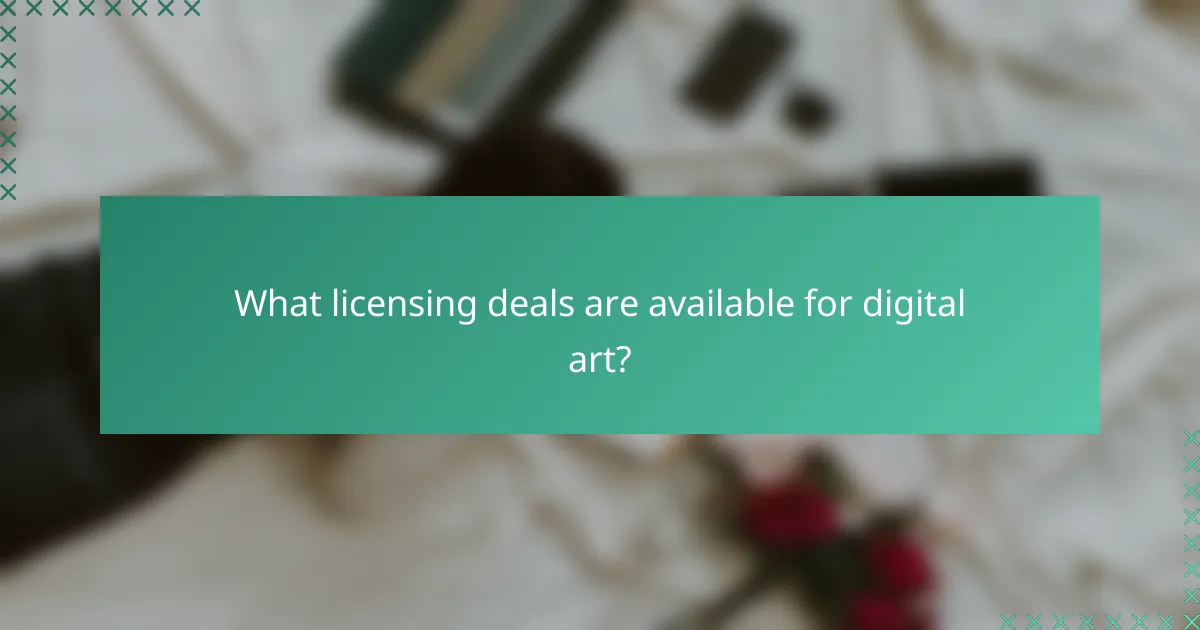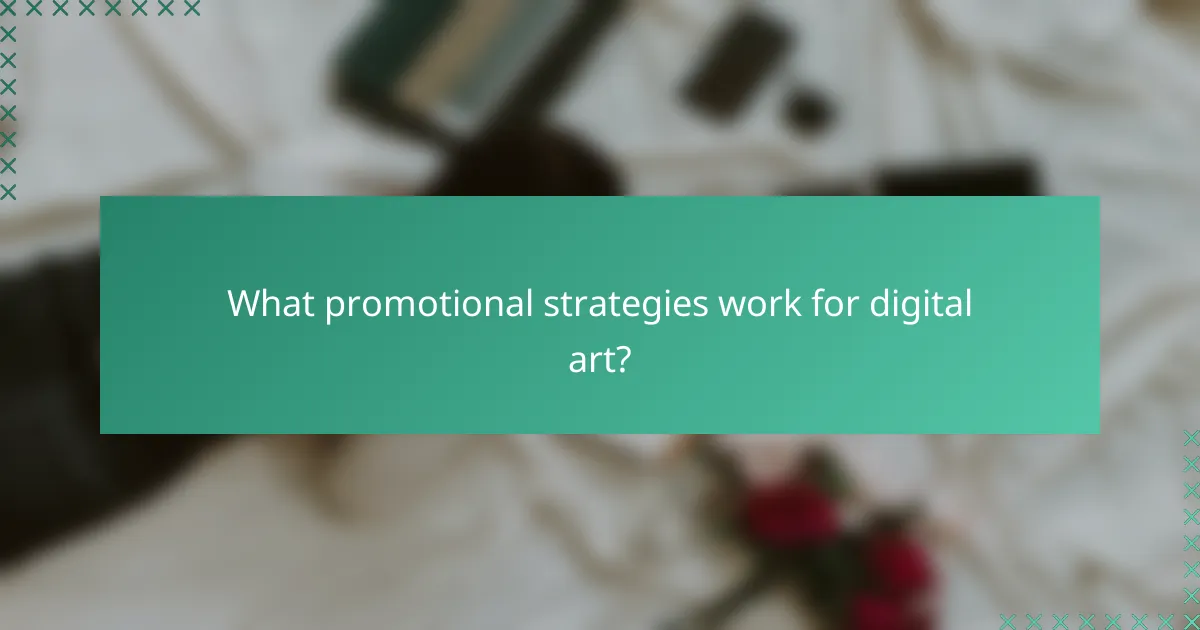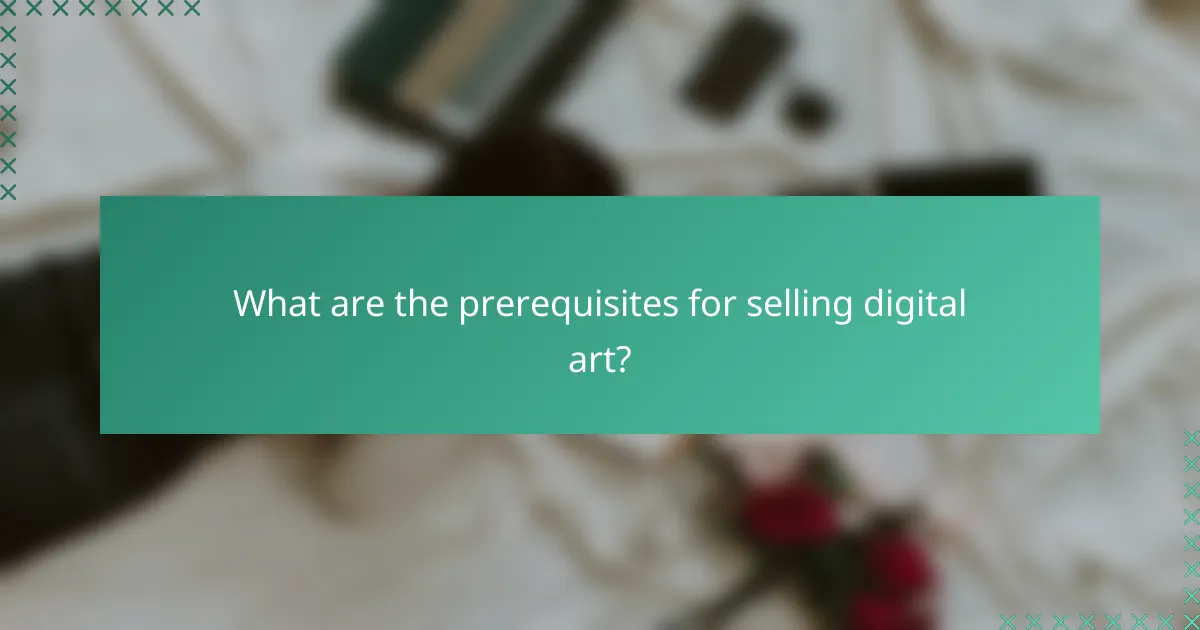Digital art has transformed the creative landscape, particularly through the use of limited editions that enhance exclusivity and perceived value. By navigating licensing deals and understanding the nuances of exclusive versus non-exclusive agreements, artists can effectively monetize their work. Additionally, implementing targeted promotional strategies, such as social media engagement and influencer collaborations, can significantly boost visibility and sales in this competitive market.

How to create limited edition digital art?
Creating limited edition digital art involves defining the number of copies available, selecting the right platforms for distribution, and establishing effective pricing strategies. This approach enhances exclusivity and can increase the perceived value of your artwork.
Define edition size
Edition size refers to the total number of copies you plan to sell. A smaller edition size, such as 10 to 50 pieces, often creates a sense of scarcity, which can drive demand and increase prices. Consider your audience and the medium when deciding on the size; limited editions of 5 to 20 are common for high-value artworks.
Be mindful that once you set an edition size, it should remain fixed to maintain the integrity of the limited edition. Changing it later can undermine trust with your buyers.
Choose distribution platforms
Selecting the right distribution platforms is crucial for reaching your target audience. Popular platforms for selling limited edition digital art include online marketplaces like Etsy, Saatchi Art, and specialized NFT platforms such as OpenSea or Rarible. Each platform has its own audience and fee structure, so evaluate them based on your goals.
Consider using a combination of platforms to maximize exposure. For instance, you might sell directly through your website while also listing on an NFT marketplace to tap into different buyer demographics.
Set pricing strategies
Pricing your limited edition digital art requires careful consideration of factors like edition size, your reputation, and market demand. A common strategy is to start with a lower price for the first few pieces to attract buyers, then gradually increase prices as the edition sells out. This can create a sense of urgency.
Additionally, consider offering tiered pricing based on the edition number; for example, the first piece could be priced higher than the last. Always research similar artworks to ensure your pricing is competitive.
Utilize blockchain for authenticity
Using blockchain technology can enhance the authenticity of your limited edition digital art. By minting your artwork as an NFT (non-fungible token), you create a verifiable record of ownership and provenance that buyers can trust. This can significantly increase the value of your art.
When utilizing blockchain, choose a reliable blockchain platform that supports NFTs, such as Ethereum or Tezos. Ensure you understand the associated costs, including gas fees, which can vary widely depending on network congestion.

What licensing deals are available for digital art?
Licensing deals for digital art typically fall into two main categories: exclusive and non-exclusive agreements. These deals define how the artwork can be used, who can use it, and the financial arrangements involved.
Exclusive licensing agreements
Exclusive licensing agreements grant one party the sole rights to use the digital artwork, preventing the artist from licensing it to anyone else. This type of deal often commands higher fees due to its restrictive nature, making it attractive for businesses seeking unique content.
When negotiating an exclusive license, consider the duration and scope of use. For example, an exclusive license might cover specific media, such as print or digital advertising, and last for a set number of years. Ensure that both parties clearly outline these terms to avoid future disputes.
Non-exclusive licensing options
Non-exclusive licensing options allow multiple parties to use the same digital artwork simultaneously. This flexibility can lead to lower licensing fees and broader distribution opportunities for the artist.
Artists often use non-exclusive licenses to maximize their revenue by licensing the same piece to various clients. However, it’s essential to specify the usage rights, such as whether the artwork can be altered or if it can be used for commercial purposes.
Royalty structures
Royalty structures in licensing deals determine how artists earn income from their work. Common arrangements include one-time fees or ongoing royalties based on sales or usage metrics.
For instance, an artist might receive a percentage of sales generated from products featuring their artwork. Typical royalty rates can range from 5% to 20%, depending on the agreement’s specifics and the artwork’s popularity. Artists should carefully evaluate these structures to ensure fair compensation for their work.

What promotional strategies work for digital art?
Effective promotional strategies for digital art include leveraging social media, conducting email marketing campaigns, and collaborating with influencers. These methods can significantly enhance visibility and engagement, leading to increased sales and brand recognition.
Social media marketing
Social media marketing is a powerful tool for promoting digital art, as platforms like Instagram, Facebook, and Pinterest allow artists to showcase their work visually. Regularly posting high-quality images, engaging stories, and behind-the-scenes content can attract followers and potential buyers.
Consider using targeted ads to reach specific demographics interested in digital art. Utilize hashtags relevant to your niche to increase discoverability and engage with your audience through comments and direct messages to build a community around your art.
Email marketing campaigns
Email marketing campaigns can effectively reach existing and potential customers, keeping them informed about new releases, limited editions, and exclusive offers. Building a mailing list through your website or social media can provide a direct line of communication with your audience.
Craft compelling newsletters that include visuals of your latest work, upcoming events, and personalized messages. Aim for a consistent schedule, such as monthly or bi-weekly, to maintain engagement without overwhelming your subscribers.
Collaborations with influencers
Collaborating with influencers can expand your reach and credibility in the digital art community. Partnering with influencers who resonate with your style can introduce your work to their established audiences, often leading to increased interest and sales.
When selecting influencers, consider their engagement rates and alignment with your brand values. A successful collaboration might include joint giveaways, features on each other’s platforms, or co-created content that showcases both your art and the influencer’s personality.

What are the prerequisites for selling digital art?
To sell digital art successfully, artists need to understand copyright laws, create a strong online portfolio, and establish effective promotional strategies. These elements are essential for protecting their work and attracting potential buyers.
Understanding copyright laws
Copyright laws protect the rights of artists by granting them exclusive control over their creations. In most countries, including the United States and those in the European Union, copyright is automatic upon creation, but registering your work can provide additional legal benefits.
Artists should familiarize themselves with licensing options, such as exclusive versus non-exclusive licenses, to determine how they want to sell their art. For instance, an exclusive license allows one buyer full rights, while a non-exclusive license permits multiple sales.
Building an online portfolio
An online portfolio is crucial for showcasing digital art and attracting potential buyers. Artists should select a user-friendly platform that allows for high-quality image uploads and easy navigation. Popular options include personal websites, social media, and art-focused platforms like Behance or ArtStation.
When creating a portfolio, focus on presenting a cohesive body of work that reflects your style and expertise. Include detailed descriptions, pricing information, and licensing terms to inform potential buyers about your offerings. Regularly updating the portfolio with new pieces can also help maintain interest and engagement.

How to price limited edition digital art?
Pricing limited edition digital art requires a strategic approach that considers various factors, including market trends, production costs, and perceived value. The right price not only reflects the uniqueness of the work but also appeals to potential buyers.
Market research on similar works
Conducting market research involves analyzing the pricing of comparable digital art pieces. Look for works with similar themes, styles, and editions to gauge a reasonable price range. Platforms like ArtStation or Saatchi Art can provide insights into current market rates.
Consider factors such as the artist’s reputation, the artwork’s complexity, and the size of the edition. For instance, limited editions with fewer copies typically command higher prices than those with larger runs.
Cost of production analysis
Understanding the cost of production is crucial for setting a profitable price. This includes expenses related to software, hardware, and any promotional materials. Calculate the total investment to ensure the price covers these costs while allowing for a profit margin.
For example, if your production costs total around $200, consider pricing your limited edition art at least 2-3 times that amount to account for market fluctuations and perceived value.
Perceived value assessment
Perceived value plays a significant role in pricing limited edition digital art. Factors such as the artist’s brand, the exclusivity of the piece, and the emotional connection it creates can elevate its perceived worth. Engage with your audience to understand what they value in your art.
Utilize marketing strategies like storytelling or highlighting the creative process to enhance perceived value. For instance, sharing behind-the-scenes content can make buyers feel more connected to the artwork, justifying a higher price point.

What are the benefits of licensing digital art?
Licensing digital art offers creators a way to monetize their work while retaining ownership. This approach can lead to multiple revenue streams and increased visibility in the market.
Revenue generation
Licensing digital art can create significant revenue opportunities for artists. By allowing companies or individuals to use their artwork for specific purposes, artists can earn royalties or upfront fees. For instance, licensing a piece for merchandise or advertising can yield payments ranging from a few hundred to several thousand dollars, depending on the usage and audience reach.
Artists should consider various licensing models, such as exclusive versus non-exclusive agreements. Exclusive licenses typically command higher fees but limit the artist’s ability to license the work to others, while non-exclusive licenses allow for broader distribution and potentially more income over time.
Brand exposure
Licensing digital art can significantly enhance an artist’s brand exposure. When artwork is featured in commercial products or marketing campaigns, it reaches a wider audience, potentially leading to new fans and customers. For example, a popular brand using an artist’s work in their advertising can introduce the artist to thousands of potential buyers.
To maximize brand exposure, artists should choose licensing partners that align with their style and values. Collaborating with well-known brands can elevate an artist’s profile, but it’s essential to ensure that the partnership reflects the artist’s vision and maintains their integrity.
